This website is supported by its readers. If you click one of my links I may earn a commission. I am also a participant in the Amazon affiliates program and I will also earn a commission from qualified purchases.
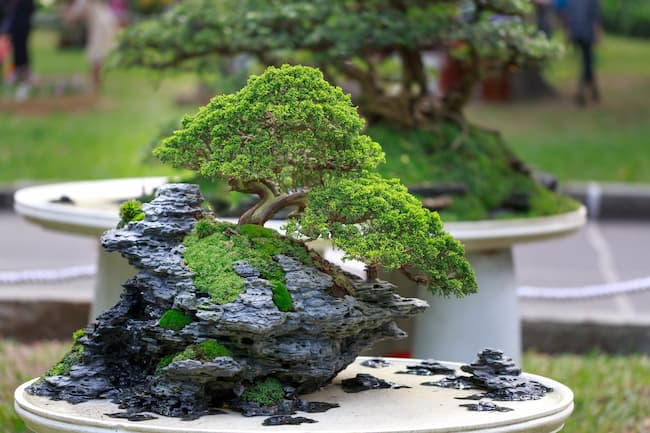
So recently, I’ve noticed that part of my elm bonsai tree trunk has become slightly squishy. At first, I thought it was nothing to worry about, but the longer I’ve left it, the more squishy the trunk seems to have gotten. As such, naturally, I’m asking why my bonsai tree trunk is squishy.
A squishy bonsai trunk is due to overwatering. This causes the tissues under the bark to die back. Constant overwatering causes a build-up of fungi and root rot in your bonsai tree.
Bacterial infection can also cause sap to leak from elm trees, leading to a squishy bonsai trunk.
So is there anything you can do to revive a bonsai tree with a squishy trunk? And what species of bonsai are more susceptible to a squishy trunk? Keep reading to find out more!
Just a quick heads up, over the past three years of running Plantpaladin, hundreds of people have asked for product recommendations. As such, You can find my favorite indoor bonsai tree here (link takes you to Bonsaiboy), my favorite outdoor bonsai tree (link takes you to Bonsaiboy), or have a look at all the products I recommend here.
Why Is My Bonsai Tree Trunk Squishy?
Bonsai trees provide the ultimate natural addition to your home. The miniature tree form originated centuries ago. Consequently, after years of the bonsai tree’s existence, its care routine has been passed down and perfected.
You may have gone to water your bonsai but noticed something spongey about its trunk. You’re probably wondering, “Why is my bonsai tree trunk squishy?”
This is precisely the same question I had. So I got in touch with a few gardening experts, visited my local botanical gardens, and even surveyed ten plant paladin readers.
All to ensure you have the most in-depth post on why your bonsai tree trunk is squishy.
To summarize:
- The most common cause of a squishy bonsai trunk is due to overwatering.
- Too much watering can cause the roots of your bonsai tree to become waterlogged.
- Root rot will soon develop if waterlogging is not resolved via planting in the ground or drying out the roots.
- Root rot is a fungal infection that inhibits your bonsai trees’ ability to absorb and process nutrients from the soil.
- Over time this will weaken your tree and eventually kills the tree section by section.
- A squishy bonsai trunk is mainly due to the inner wood of your bonsai dying under the tree’s bark.
- As the tree begins to rot, the trunk can no longer support its weight and becomes squishy.
- Squishy bonsai trunks are most common in bonsai trees that don’t need as much watering.
- As such, indoor bonsai trees such as ficus, elm, or succulents such as Jade are most commonly impacted by squishy trunks.
- Only water your bonsai tree when the topsoil is dry to prevent a squishy trunk.
- Elm trees also drip sap from time to time due to bacterial infections, which typically cause a wet spot on the bonsai’s trunk.

Thanks to years of care, experts have cultivated a solution to bonsai trunk rot. Your bonsai tree may have some luck surviving.
Stick around to learn more about why your bonsai tree trunk feels squishy and what you can do about it.
What Causes a Squishy Tree Trunk?
A squishy tree trunk is, more often than not, indicative of tree trunk rot. Various issues could cause this condition. Some of these include overwatering, lack of air circulation, and more.
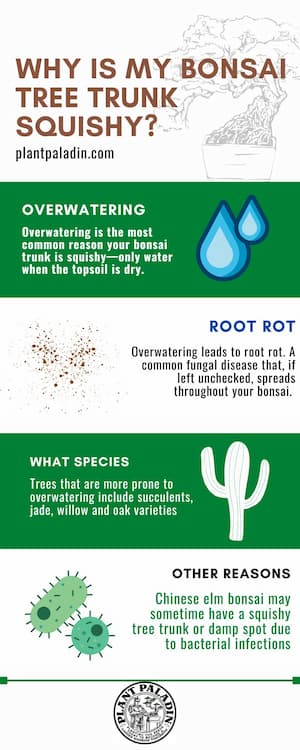
Overwatering Your Bonsai Tree
Overwatering is the most common cause of a squishy bonsai tree trunk. Watering a bonsai tree isn’t like watering any other regular plant. For one, the tree requires a different technique.
It involves soaking the tree’s pot in a water tray until the soil absorbs all its necessary moisture. You may have left the tree in the tray too long, which causes over-absorption. This is why lots of beginner bonsai owners tend to overwater the plant.
In addition, you may feel the need to overwater your bonsai if you forgot to water it last time. This will only lead to a higher risk of the tree developing root rot.
Root Rot
After overwatering the bonsai tree, root rot can seep its way into your plant’s lower half. The root rot can slowly reach the tree’s trunk if left unnoticed. This is when you’ll likely recognize its squishy exterior.
Aside from that, root rot is a common plant disease caused by fungal or bacterial growth in your roots. A couple of these diseased pathogens are called phytophthora or verticillium. The latter is highly common in certain bonsai species, like the maples.
Air Circulation Issues
After adequately watering your bonsai tree, you may still face an issue of over or underwatering. To clarify, the air surrounding the tree can cause the soil’s water to evaporate too fast or slow.
This highly depends on your bonsai tree’s placement. For instance, if you put it in a cool area with AC, the water inside the soil won’t evaporate fast enough.
Meanwhile, a warmer region can cause the water to evaporate faster than needed, which may cause underwatering.
If the air isn’t dry enough or your water holds on to water too much, consider investing in better potting soil that equals moisture retention, moisture flow, and oxygen.
Can You Revive a Bonsai Tree with a Squishy Trunk?
Reviving a bonsai tree with a squishy trunk is plausible, but that mainly depends on its roots’ situation. You’ll want to examine whether all the roots have died out or if you see some remaining healthy.
Apart from the roots, you can also use the squishy trunk as an indicator. You’ll need to gently scrape off a piece of the bark and inspect the area. If it’s still a healthy green, your bonsai may have a chance at a longer life.
On the other hand, you might feel a few weak spots that feel like they might break easily. In this case, it may be time to say goodbye since the trunk rot has advanced.
Signs Your Bonsai Tree Has Trunk Rot
Aside from a squishy trunk, other signs can also help point to trunk rot in your bonsai tree. For instance, you can look at other parts of the plant, like the leaves. They provide one of the best means of identifying any illness in your bonsai tree.
Discolored Leaf Tips
When a bonsai tree is experiencing trunk rot, you may notice the illness spreading to the tree’s leaves. Their tips will appear brown or black, or yellow.
This symptom usually happens before the squishiness settles in the trunk. For this purpose, you’ll want to be wary of any discoloration on your bonsai’s leaves.
Weak Trunk
With a weak root base, if you try to push the trunk, it will wobble a bit unsteadily. This is highly indicative of a diseased bonsai tree.
In contrast, if the tree remains sturdy, this is a good sign that your tree may survive after repotting.
Swollen Trunk
After being overwatered, the trunk may become swollen with excess moisture. Albeit, the swelling won’t be significant, but still unmistakable.
The bottom Trunk is damaged
Check the bottom area of the bonsai’s trunk.
Trunk rot will render the base damaged, peeled, and broken.
Once you feel brittleness in the trunk, it may already be too late to save the plant. The plant will likely break apart and collapse once it has reached this stage of trunk rot.
Drooping Branches
If your bonsai looks droopy, it could be a sign of trunk rot, but it could also be a sign of insufficient sunlight.
Either way, the plant needs proper attention.
How To Treat the Root Rot That Is Causing Your Squishy Trunk?
To save your bonsai tree, you need to address the root cause of the squishy trunk, root rot. Once you’ve controlled the fungi growth, your bonsai tree has a much better chance of survival.
Step 1: Expose the Bonsai Tree’s Roots
To start your revival process, you must take the tree’s roots apart from its soil. You can use a toothpick for this process.
The bonsai may be stuck to its pot with a wire, so cut the wire first, then take the plant out. Now, assess the roots for damage.
Remember, you can’t save the already-infested roots. You can use a root rake to remove any excess soil from the roots.
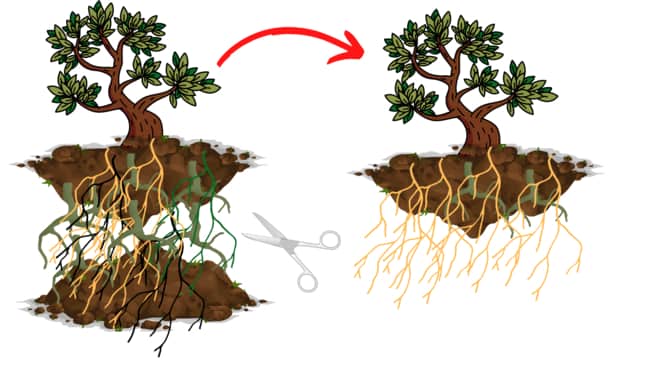
Step 2: Prune Infested Roots
Cut off all the dead root parts with a pair of scissors or shears.
They’ll appear dark and feel like cotton in texture. Contrastingly, healthy roots are white and firmer.
In this step, you may expect to cut off many roots since the disease has spread enough to reach the trunks.
Nevertheless, ensure all the dead roots are gone to ensure the root rot is taken care of for good.
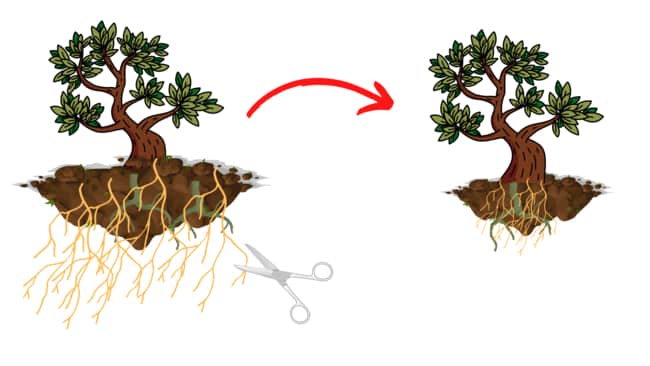
Step 3: Prepare the Bonsai Tree’s Pot
After pruning the tree’s roots, it’s time to place it back in its home. You can either use a new pot or the same pot.
If you picked the latter, ensure the old soil is well disposed of. The old pot needs to be thoroughly cleaned.
On top of that, you’ll want to spray the pot with fungicide if there are any lingering water-borne bacteria.

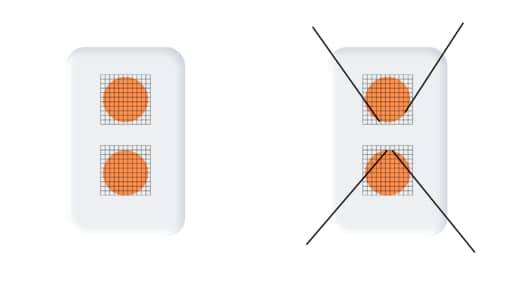
Step 4: Prepare the Bonsai Tree’s Soil
Now that you’ve gotten rid of the old infected soil, you’ll want to purchase a new mix. You can either buy a ready-made bonsai soil mix or make your own.
50% of the mix must be Akadama, also known as red ball earth. This clay-like granular material is usually used in bonsai trees and other plants grown in containers.
25% of the soil should include organic compost, while the remaining 25% should include perlite or other draining material.
If you can’t find the ready-made kind and cannot make your own, you can resort to cactus soil. It has similar drainage properties to the bonsai soil mix.
Before piling the soil in the old or new pot, add a mesh layer to keep the roots and soil inside.
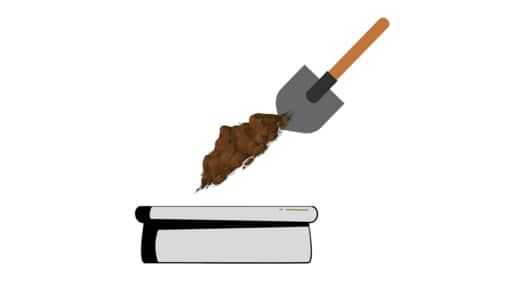
Step 5: Repot the Bonsai Tree
Now that the pot and soil are ready, it’s time to welcome your recovering bonsai to its new home. After carefully placing the tree, there’s nothing left to do but lightly water it and maintain general aftercare.
Before watering the plant, check the soil for any dampness. If it’s dry, you can go ahead and water it. From now on, you’ll want to be more watchful of your bonsai tree’s progress.
To speed up the recovery process, you can add diluted phosphorus fertilizer. This added element is especially beneficial during the winter months.
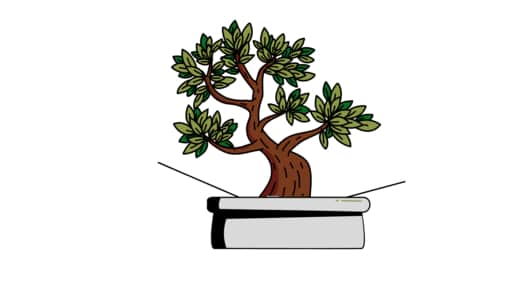
Step 6: Find the Best Placement
Since placement can affect your bonsai tree’s health, you must find an ideal spot. This mainly entails an area with little to no AC or heating.
In terms of lighting, your bonsai will need six to eight hours’ worth of indirect sunlight. All that’s left to do now is wait and hope for the best.
You’ll want to keep an eye out for any signs of recovery. It may have been too late if you see no such signs or if the tree still feels squishy.
Consider investing in artificial light to help support your bonsai trees’ light needs.
What Are the Other Causes for a Squishy Bonsai Trunk?
Besides overwatering and hindered air circulation, your bonsai’s trunk could be squishy for other reasons.
Underwatering
If the bonsai tree’s trunk feels wobbly, frail, and squishy, it may be underwatered. The leaves are usually the first telltale sign of an underwatered plant, appearing discolored and brittle.
After long periods of drought, the plant’s trunk and branches will probably collapse from weakness. If you try to water them, then it’ll be too late. Instead of the roots absorbing the water, the compost in the soil will in a reverse osmosis process.
Lack of Proper Soil Drainage
With a high risk of overwatering, you must ensure your bonsai tree’s soil pot is well-draining. Most bonsai tree soils come with draining materials such as perlite, pumice, and gravel to pour out any excess water.
Rainy Weather
Before placing your bonsai tree outside, you need to take note of the weather. Is it too rainy? In this case, you may want to rethink your choice. Alternatively, you can build a cold frame to keep your bonsai safe from rainy and cold weather.
What Bonsai Species Are Susceptible to Having a Squishy Trunk?
Bonsai trees come in numerous species. If you’re looking to own a bonsai tree as a beginner, you may want to avoid these species. They’re naturally more vulnerable to pathogenic fungi, which cause squishy trunks.
- Yew
- Acer
- Lime
- Azalea
- Box
- Apple
- Beech
- Cypress
- Succulents
How To Prevent Overwatering Your Bonsai
The leading cause of squishy trunk rot in your bonsai tree is overwatering. Although there are some methods of recuperating the plant, it’s best to try to prevent the issue from occurring in the first place.
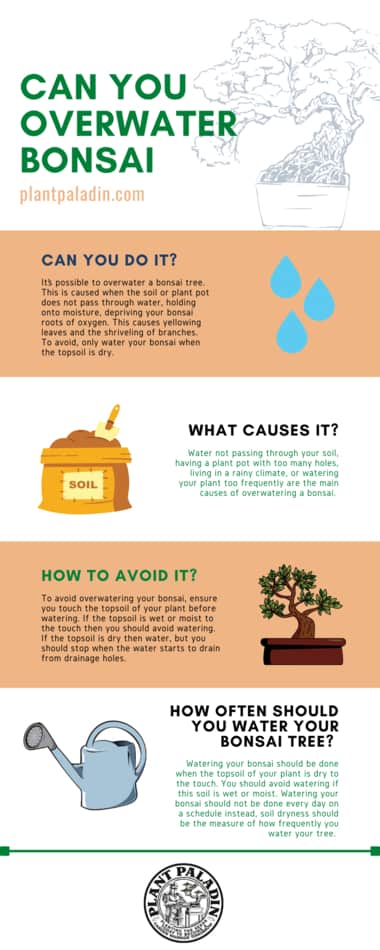
Understand Your Bonsai Tree’s Watering Needs
Each bonsai tree species has its individual watering needs. Different tree species come in varying sizes. For example, a Shito bonsai tree ranges between two to four inches in height. Meanwhile, a Chumono species can reach up to 16 to 36 inches.
This difference in height points to contrasting watering requirements. Generally, you’ll need to check the Shito variation three times per day for watering, while the Chumono, twice.
Touch the Top Area of the Soil
The best way to understand your bonsai tree’s watering needs is by touching the topsoil. If it feels dry upon contact, you can water the tree and vice versa.
Broadly speaking, most bonsai trees usually stick to one watering session every four to seven days to avoid overwatering.
Create a Watering Schedule
It can be an alarm, reminder, or even a sticky note. A watering schedule will help you keep track of your bonsai tree’s health.
Ideally, the reminder should be set daily to check the topsoil if it’s too dry. Don’t fret if you miss a day or two; bonsai trees can withstand a few days of no water, especially the succulent species.
Try a Different Method of Watering
The traditional method of watering a bonsai tree involves placing it in a tray and submerging the pot in water. That way, the water slowly seeps into the roots. This process can go on for about an hour or two.
If you’re a beginner, this process may be challenging to follow since you may not be able to recognize when the plant is sufficiently watered. For this reason, you can stick to top watering the bonsai tree. You can use a plant water sprayer or watering can.
You might also want to consider watering your bonsai tree with different kinds of water too.
How To Save a Rotting Bonsai Tree
To save a rotting bonsai tree, you must start by pruning all dead leaves and roots. Afterward, you can treat the plant with a fungicide to eliminate any traces of rotting bacterial growth.
Next, keep the treated bonsai tree aside to prepare its pot and soil. You can purchase a new pot and add some soil mix.
You can still use your old pot; just ensure the old soil is disposed of. Additionally, you must rigorously sterilize the pot to prevent future fungal development.
After pot and soil preparations, place your bonsai tree in its pot. Lastly, give it a light spritz of water and monitor its recovery.
Will Your Bonsai Die with a Squishy Trunk?
A squishy trunk can be a sign that your bonsai tree is dying. Unless you act fast and try to prevent the fungal trunk rot from spreading, the tree will likely die.
If you do manage to prune the infected roots and repot your bonsai tree, you may still see signs of no recovery. In some cases, the damage can be too significant for the plant to withstand.
Why Is the Trunk of My Bonsai Soft?
A soft bonsai tree trunk probably means it’s afflicted with trunk and root rot. Rot originates from naturally occurring pathogens.
These pathogens come from bacterial or fungal origin. Once latched onto your bonsai, they feed off of its roots. Once the roots are compromised, the pathogens begin to attack the trunk making it soft.
Your bonsai tree could be more susceptible to this disease if it has damaged and wounded roots from pruning. This is why you’ll likely find the rot coming near spring when pruning is at its highest.
Survey on why is my bonsai trunk squishy
Finally, I didn’t just want to give my expierancene, so I reached out to ten plant paladin readers and asked them why their bonsai trunks were squishy.
To summarize:

To Conclude
Why is your bonsai tree trunk squishy? In short, the squishiness mainly comes from overwatering the plant. After being exposed to too much water, the plant is more vulnerable to root rot.
The disease eats away at the plant’s root tissue and eventually travels its way up to the trunk. The trunk then becomes soft and wobbly.
The good news is that you can try to save the bonsai tree by pruning the dead roots and repotting it. Nonetheless, this method isn’t fool-proof since the rot may have caused too much damage for the plant to survive.
My top picks for the gear you will need!
So like I mentioned earlier, over the past three years of running PlantPaladin, hundreds of people have asked me for my recommendations on the best bonsai gear on the market.
Having spent thousands of dollars on bonsai items these past few years and tested at least 100 bonsai-specific products, I’ve listed my favorite products below – All of which I highly recommend and think you can get great value.
They can purchase directly by clicking the link to take them to Amazon.
Bonsai Tool Set: One of the significant challenges I’ve had is finding a toolset that was not only durable but didn’t break the bank. SOLIGT has recently developed a fantastic bonsai tool set that covers all the tools you need to trim, prune, and repot your trees. – You can grab it here.
Complete Bonsai Set: Many of you will want to grow your bonsai trees entirely from scratch, but finding the varicose seeds, pots, and other items in one place can be challenging. Leaves and Sole then have created a complete bonsai set that I’ve personally used that ticks all the boxes. You can grab it here.
Bonsai wire: The number of times I’ve run out of wire for my bonsai or purchased cheap bonsai wire that doesn’t do the job is embarrassing for me to admit. After a lot of trial and error, I found that using Hotop’s aluminum bonsai wire is one of the best options on the market. This can easily be used for both indoor and outdoor bonsai. You can grab it here.
This post was written by Fehed Nicass who has been passionate about bonsai for over 3 years.
